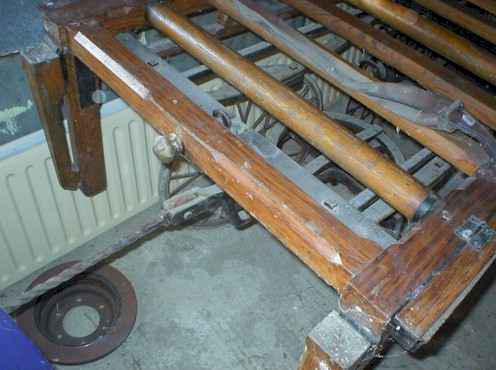The Bier
The village bier was bought in 1935, as a joint purchase by the villages of Oxhill and Whatcote. Collections were made in both villages, Oxhill contributing £20.16s. 6d, and Whatcote £10.3s 0d. In addition, a Garden Fete had been held which had raised £5.0s 0d. The actual cost of the bier, paid to Messrs. Archer & Son, was £28.0s. 0d., leaving a balance in hand of £7.19s.6d. A Parish Meeting in 1935 decided that these funds should be kept in hand for future repairs to the bier.
The following year, with Edward VIII succeeding to the throne, there was discussion at the Parish Meeting about the purchase of a flagstaff and flag for the church in time for the King’s Birthday in June. (A fortnight later, at the special meeting called to discuss the funding, the date for the unfurling of the new flag was brought forward to Empire Day, on 24th May, an occasion which was always celebrated in the village.) There were at the time a number of small village funds which were lying dormant, – the Wake Fund, the Cricket Club Fund, and the Reading Room Fund, all now discontinued in use. It was suggested that they should all be amalgamated to cover the cost of the flagstaff and flag. The Bier Fund was also mentioned but it was pointed out that a third of this belonged to Whatcote. It is not entirely clear from the Minutes how this matter was finalised, and while the Parish Meeting agreed that the cost of flagstaff and flag should be met out of an amalgamation of the first three Funds, (to be renamed the Village Fund), there was no further reference made to the Bier Fund.
The new bier was to be used by both Church and Chapel alike. Funerals at that date were dealt with within the village, with the coffins being made by the village carpenter, and the bier was to be used to transport the coffin from the home of the deceased to the Church or Chapel. It replaced a far more primitive plain wooden bier, without wheels, kept at the Rectory.
The bier was kept for many years at the Methodist Chapel until gradually it became more common for undertakers from outside the village to be used for funerals, and it became redundant. In 1965 the Methodist Minister wrote to the Parish Meeting regarding a new home for it, and since that date, it has moved several times within the village. In 1982 enquiries were made of Warwick Museum to see if it could be accepted there on loan, but this initiative was unsuccessful, and it continues to be housed privately in the village.
Research continues and as soon as more information becomes available it will be posted here.


